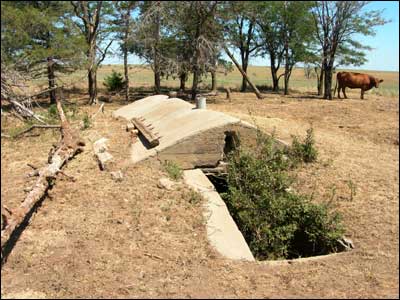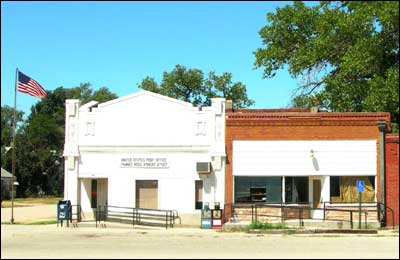
|
|
|
Search our site
Check these out    Do you have an entertaining or useful blog or personal website? If you'd like to see it listed here, send the URL to leon@pawneerock.org. AnnouncementsGive us your Pawnee Rock news, and we'll spread the word. |
Too Long in the WindWarning: The following contains opinions and ideas. Some memories may be accurate. -- Leon Unruh. Send comments to Leon February 2009Alfalfa nocturne
[February 28] Judging by the response of my friends and family, not many people enjoyed the aroma of baking alfafa coming from the dehydration plant on the east end of Larned. But to me, there was no better smell on a summer night as we drove past with the windows open. In these perilous financial times (they were bad in 1975, too), it seems silly now to admit that sometimes I, as a teenager, would drive to Larned in the evening just to smell the smoke. So I won't say that, but it was a convincing reason to drive the eight miles if I were inclined to go anyway. The summer I worked at a fireworks stand outside Leon Rankin's butcher shop, which was just downwind from the plant, was a treat. The bright lights, the banging, the truck traffic, and the boyhood joy at being next to a place that Made Something Useful is a combination I intend never to forget. I had spent several long days bucking heavy alfalfa bales onto trailers, so I felt a kinship -- albeit remote -- with the process. A couple of years ago I drove into Larned on an August night, hoping for a whiff of my old pleasure. What I got instead was the stench of used alfalfa, rolling north on a dust cloud from the expanded feedlot about four miles south. I won't say the alfalfa magic has been overpowered; still, I am sad to report that I have since placed my beloved alfalfa-plant memories into the cardboard box marked "the way it used to be." The Rock, sideways
[February 27] History tells us that Pawnee Rock was a towering bluff of sandstone with a commanding view of the Arkansas River Valley and the rolling country to the north. History also tells us that the Santa Fe Railroad crews and the men who built the town of Pawnee Rock quarried a lot of sandstone from the Rock. And that's why we are left with this particular view of the Rock from the east. In my young years, my mind carried two Rocks. There was this view, taken from the Mennonite Church road, and there was the imposing Rock viewed from the park entrance. From this angle, and even moreso when viewed from U.S. 56, the Rock is hardly noticeable; a stranger driving down from Great Bend might pass without grasping the significance of the scenery. In an odd way, that also made me proud. I knew the Rock was special, historically and geologically, and I was glad that my knowledge came from living at its base. We had what was once the most feared landmark along the trail, although the stonecutters and the trees and the settlement at its feet had rendered it almost insignificant to highway traffic. We didn't suffer from cheap tourism; only smart, curious folks stopped to see our Rock. Although the view was unmatched from atop the pavilion, the Rock was our secret landmark in plain sight. But, you know, after looking at the way the Rock fits into the landscape, I sometimes wonder whether our town's beloved legend is true: that the Rock was twice as high as it is now. It seems just as likely that the crews took most of their sandstone from the face -- where it was easy to break off and put on wagons -- instead of from the top. C. Kay Beckwith dies[February 27] Carroll Kay Beckwith, a man who many of our Pawnee Rock families knew professionally, has died in Larned. Mr. Beckwith was for 33 years a funeral director -- the third generation of his family to run Beckwith Mortuary. He was also a Methodist, Rotary member, golfer, bowler, and pilot. His funeral will be Saturday at the Beckwith Mortuary Chapel and he will be buried in the Larned Cemetery. (Obituary) Go, dog, go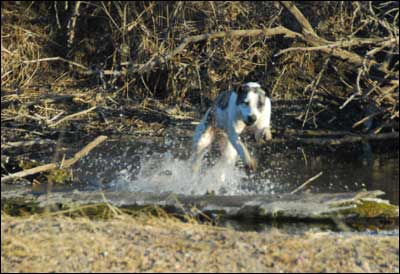
[February 26] Dogs, especially big-knuckled and floppy-eared pups of any age, enjoy life rambunctiously. They hardly care what they eat, they don't care what they roll in, they love to jump into cold water up to their thighs, and then their life just isn't complete until they give you a big hug. That's the kind of dog I like. This photo, made by Jim Dye of one of his companions at the Arkansas River, brings out my smile. Not just for the happy dog, but for the days I spent wandering the riverbed, looking for rocks and fish and good places to camp. Aside from inside a book, the river might have been the only place where I felt like a happy dog. Everyplace else -- school, my darkroom, my grandparents' farm -- had boundaries and expectations. The river, however, was free country and I splashed all I wanted. Doyle Mayse, radio reporter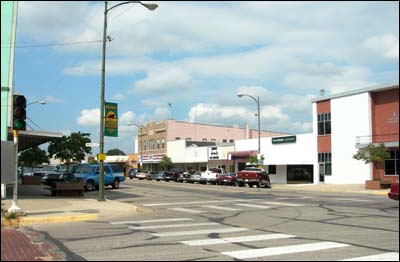
Broadway in Larned, 2006. [February 25] I read in the Great Bend Tribune obits this week (February 24) that Verna Clara Mayse had died. I didn't know her, but I was slightly acquainted with her son, Doyle. Those who listened to KANS radio in Larned were familiar with his name. He was the station's man on the scene at fires and accidents, having arrived as fast as almost-legally possible in his yellowish Mustang or Barracuda (the model escapes me) decorated with whip antennas. Doyle, I think, was one of those fellows who lived for his job. I'm certain that whoever owned KANS didn't pay him nearly what he deserved for prowling the streets six or seven days and nights a week plus the studio time plus the interminable hours spent sitting through meetings. Before I saw Doyle for the first time, I expected him to be a dashing fellow with dark curly hair and muscles that burst out of his shirt. That's what his radio voice sounded like. The real Doyle wasn't like that. I remember him with a sallow appearance and with straight hair that was a couple of weeks past due for a haircut. Still, I was excited the first time someone identified him on the street -- besides Major Astro, Doyle Mayse was my first broadcasting celebrity. At the time I met him in the mid-1970s, I was his competitor. I was a reporter and photographer for the Larned Tiller and Toiler. I listened to him on the radio and got ideas and directions to the action, and he read our reporting and developed his own stories. We were like two sharks circling the same prey; the difference was that he knew what he was doing. He was everywhere, and then he was gone. I don't know what Doyle Mayse has been up to since I left central Kansas, although I see that he still haunts the radio waves. But for those magical high school and college years when Larned was my new world, Doyle was my ideal Kansas radio reporter. Evening on Santa Fe Avenue
The north side of the 400 block of Santa Fe Avenue, July 2005. [February 24] We lived in the house just west of the old fire station, and our avenue was named for the Santa Fe Trail. Woods grew across the street from us, and our back yard was practically a nature park. I rode my bike up and down our block in the evening, bouncing over the sidewalk bump between the big elm and the picket fence on Mrs. P.H. Unruh's house (later the Flicks' house), and dashing back into the sunset past the fire station and the homes of the Unruhs, the Tutaks, and the Germans. These were the best evenings, a time of calm and of possibility. There was a chance that someone interesting would be playing tennis, and I could watch. Or maybe Lawrence Bright would have his little racing car whining around on the tennis court. When I was left to my own imagination, I drove a spaceship or a submarine or a race car on the sidewalk, depending on what I was reading that week. Yesterday my sister, Cheryl, and I were comparing notes about Mrs. P.H. Unruh's yard. We loved its hollyhocks and white picket fence, and it turns out that we both pictured her garden when we thought of "Mary, Mary, quite contrary, how does your garden grow? With silver bells and cockle shells, and pretty maids all in a row" because it was the lushest fenced garden we knew. All of that is why I have taken my sons up and down that street when we have gone to Pawnee Rock on vacation. I watch their eyes and try to see what they do. I don't bore them with everything little thing I remember, but being there with them helps me relive my fun when I was their age. And in 20 years maybe they'll do the same thing with their kids on the street where we live now. Life in Nettleton
[February 23] Larry Mix of the Santa Fe Trail Research Site in St. John found another old photo from Nettleton, the hamlet to the west that gave so much of itself to our hometown. The Pawnee Rock residents of the early 20th century must have dressed much like this. Larry wrote: "This is said to be the general store. Looks to me like it may have been store and living quarters, don't know that for sure. We had a close neighbor lady who went to the brick school and she remembered this general store. Hello, Ed Durall[February 23] If anyone is seeking a former Pawnee Rock resident who has led an interesting life, look no further than Ed Durall of Florida. Ed DurallI was thrilled to see the pawneerock.org web site. Here is my story. My name is Ed Durall. I was known as "Eddie" when we lived in Pawnee Rock. My email address is PR-edurall@aol.com. [Delete the "PR-" from the address.] We lived in PR from 1945 to 1957. I graduated from PRHS in 1954. My classmates were Jo Ann Barrett, Barbara Blackwell (deceased), Twila Boese, Lois Brock, Sue Flick (deceased), Harold Gehle, Audrey Geil, Shirla Moore, Gene Mull, Phyllis Sayler and Don Schultz (married), Jaydee Schmidt, Vernon Skolaut, Frank Smith Jr., Jim Bob Svatos (deceased), Jack Waggoner, and Jimmie Woelk (deceased). My father, Ferrol, also know as FJ, worked in the oil field and my mother, Mildred, was a housewife. I had two brothers, Jake (four years younger) and Mike (10 years younger). Mike lives in Boulder, Colorado. Jake died from pancreatic cancer on November 23, 2008. When we first moved to PR, we lived in a small brick house at the south end of Rock Street. We didn't know that street had a name at that time. The Coopers, Gregg, Louise, Gary, and Sandra, lived just to the west of us. They later moved to across the street from the grade school (the old one). Dad also drove a school bus for a few years. He hit a pig with a bus one day. He said there was a bunch of them on the right and a single on the left and his only choice was to take the single. We later moved to the corner of Cunnife and Houck Streets, across the street from the (old) high school. We had a huge upstairs bedroom. It was big enough for a ping pong table. We had big ping pong games there in the afternoons of ballgames. Jake was only in junior high, but he was the champ. He was left-handed and had a wicked cut nobody could stop. Several years after we left, that house burned down. The Frys lived next door to the west and Hubert and I became pretty good friends. I'll never forget his funeral. John Deckert lived next door to the south and the Howertons lived south of him. "Tweet" cut our hair. A Converse family lived across the street north of us and a Houdyshell family lived across the street to the east. Jake's 4th grade teacher, Roy Gertson, lived with us for a while, and a high school teacher, John Tomanek, ate meals with us. We used to have some wild Canasta games. Dad and Hubert would cheat. Several years later, I ran into Roy Gertson in a restaurant in Branson, Missouri. We later moved again to the corner of Santa Fe and Houck, across from the old grade school. Ted and Bea Allen had lived there. Ted became a grade school principal in Hamilton in southeast Kansas. When I was a junior at Fort Hays State, Ted called and offered me the job of 6th grade teacher and junior high basketball coach. I got the job and taught there for two years, but only one year for Ted. They moved back to Oklahoma. Ted was a phys ed teacher down there and died of a heart attack while teaching a class. In the meantime, our band teacher, Robert Fry, quit teaching and became an accountant in Madison, Kansas, just a few miles from Hamilton. Mr. Fry did my taxes for me one year. While he was at PRHS he once said that you don't have to be crazy to be a high school band teacher but it helps. In 1957, Dad was transferred to Hays. They lived there until Mom died in 1993 and Dad died in 1999. I went to Fort Hays and graduated in 1960. Don Schultz and I were roommates the first two years we were at Fort Hays. He and Phyllis then transferred to K-State. I was a teacher for several years. I then got a master's degree from Texas A&M and a PhD from Florida State. I worked in the military simulation and training business in Washington, DC, and Florida until I retired in 1997. I've been working part-time doing taxes for H&R Block since then. We live in the Orlando, Florida, area. I have fond memories of Pawnee Rock and my school years there. I remember the square dances on the tennis court and the Mennonite preacher going around taking names. I remember Stanley Tutak's soda fountain and the wonderful stuff you could buy there. I remember the party line crank telephone system. I remember getting television for the first time and being amazed by the Jackie Gleason show and the June Taylor dancers. We watched everything that was on, including something called Kansas Kitchen. I remember the free movies on Thursday nights in Albert in the summer. The basketball games in that cramped little gym were quite an experience. I wish we could have won more games. I remember going down to Hudson or up to Bison and getting slaughtered in football . . . six-man football . . . I guess I'm showing my age. The PRHS class of 1954 is having our 55th reunion on September 12, 2009, at the Perkins Restaurant on West 10th Street in Great Bend. We plan to meet about 5 and probably eat around 6. Anyone is welcome to stop by for a chat. We'd be glad to see you and get reacquainted. IĠd be real happy to hear from anyone out there. Abe and Susie Schultz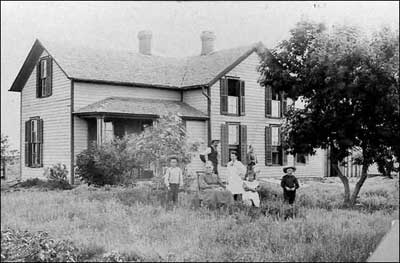
[February 22] It appears that the photo of the family on the homepage yesterday, sitting in their grassy yard, is of Abe and Susie Schultz. Susie was a sister of my great-grandmother Lizzie Schultz, and Abe was a brother of my great-grandfather Sam Schultz. Lizzie and Sam produced Lena, who married my grandfather, Otis Unruh. That would explain why my dad had the photo and why my mom, Anita Byers, knew who it was. Writing independently, Don Ross concurred with the identification. He wrote: "Could that be the Schultz house just west of the Mennonite church? The first house west was Ed Unruh and the second one on the north side of the road was the Schultz house. It's where Leslie and I think Dewey were raised." Abraham and Susie left a long legacy to Pawnee Rock. Their children were Walter Schultz, Frank Schultz, Roy (Dewey) Schultz, Virgie Schultz Deckert, Verna Schultz, Lena Schultz Hanson, Sadie Schultz Gore, Leslie Schultz, and Juanita Schultz Miller. Leslie, of course, was the father of Rhonda, Debra, and Marla Schultz. Virgie was the mother of Marilyn Deckert Smith, who was the mother of Wesley, Durwin, Bruce, and Mark Smith. Dewey Schultz (who married Alice Irion, who died this past week at age 101) operated the Brown Swiss Dairy farm south of town. What's neat about Nettleton[February 22] Leon Miller gives us the architect's perspective of the Nettleton School, which provided our town with the bricks for the Methodist Church: The picture of the Nettleton school is intriguing to me as it has several distinguishing architectural features uncommon for the time, compared to other schools, such as the old Pawnee Rock High School. These include the asymmetrical position of the windows in the front and sides of the building, the lack of ornamentation and the crisper lines at the top. The long stairway at the front entrance gives one to imagine that the architect was providing for shelter from tornadoes on the lower floor, perhaps a basement that would protect the students should the inevitable Kansas tornado make it presence. Most architectural designs for educational facilities of the time consisted of a straight, coordinated facade with much decoration and the exterior symetrically. The Nettleton school could fit in with today's designs of a more "modern" style of architecture. One thought leads to another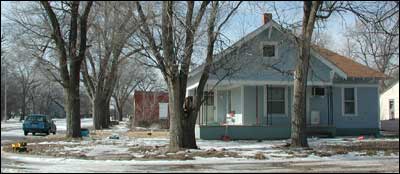
House at the intersection of Centre Street and Santa Fe Avenue; Rick Clawson was rescued by the woman who lived here in the early 1960s. [February 22] Rick Clawson writes from Nevada: Reading your column on the bricks and the connection with Phillip Anschutz, I once worked with a teacher by that name who claimed he was a nephew of Phillip Anschutz. I never bothered to verify it, but in the two years we worked together that was his claim, but his name had an "e" after the "u", and was spelled Anschuetz. Interesting story here about the bricks. I have learned a few things about my home town. Or should I say, "It goes to show how little I really knew about my small world, my Mayberry RFD. I even found out by a question posed by Cheryl that my dad did actually work for my uncle A.B., I guess before I knew how to ride a tricycle, and how to get lost in Pawnee Rock, which I remember doing when I was quite small. I followed my brother Jeff to your side of town and didn't know my way home. As I recall I was rescued by a lady who lived in the house on the east corner from where you lived. The red brick road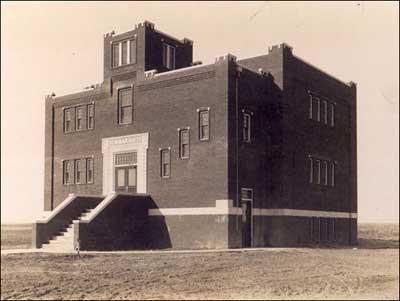
Nettleton School, 1915. Photo sent by Larry Mix. [February 21] Kay Steed, who started us on the discussion of bricks, says: "Thanks to you and all the other folks who sent in memories about the brick churches. I'm still wondering what the name on the bricks might have been. "Anyway, I do have a little more info on the Pfister children, other than the ones who were mentioned. They were: Marian Anschutz, Helen Converse, Melba Converse, Doris Wilmouth, Irene Dring, Avis Drake and Cecil Pfister. I will ask my son if he'll please get a little more information from the lady in Tonganoxie, the next time he is there. "It's very interesting to read everyone's ideas when you pose a question. "Thank You." And a special thanks to Larry Mix of the Santa Fe Trail Research site in St. John, whose familiarity with the upstream settlement of Nettleton produced the 1915 photo of the school that gave up the bricks that were turned into the Methodist Church (and present city hall) in Pawnee Rock in the 1940s. Isn't that a great photo? You can imagine how windy it is in Nettleton, and that school is four-square like a block. When you look closely, you can see the dust caught up in the lower bricks -- and notice how flat and empty that river-bottom land is. Alice Schultz dies[February 21] Alice Schultz, who used to live south of Pawnee Rock and about halfway to Radium, has died in Missouri. She was 101 years old.
Dewey Schultz died in 1986. At her death, Alice Schultz lived in Savannah, Missouri. She will be buried Monday in the Larned Cemetery. (Obituary) (Larry Smith sent the image of the milk-bottle cap.) The bricks and the churches
I wondered aloud where Pfister bricks might have been used in Pawnee Rock. I suggested that perhaps it was the Methodist Church, now the City Hall. The wooden Methodist Church burned in the early 1940s and was rebuilt with bricks. The Mennonite Church was dedicated in 1915, and the New Jerusalem Church was built around that time, too.
Several folks -- Leon Miller, Brenda Jones, and Susan Ellis among them -- wrote about the Methodist Church, Pfisters, and bricks. We didn't solve the mystery of how exactly the Pfister bricks were used, but what we do have is more pieces for the Pawnee Rock jigsaw puzzle. As you'll see, there's some disagreement over exactly where the bricks for the Methodist Church came from. The safe answer is "the Kinsley area." Offerle, which still exists, is seven miles west of Kinsley on U.S. 56. Nettleton, which was a settlement built at a train station, sat seven miles northeast of Kinsley, just inside Edwards County and near where U.S. 183 joins U.S. 56. Leon Miller (Dallas)
About the bricks, I remember the contractor was able to locate the bricks from a building that was being dismantled in Offerle, Kansas, and was the only way the project could proceed as everything was being sacrificed for the war effort. As to whom the lady named Pfister living in eastern Kansas was, I wouldn't have a clue. The patriarch of the family was Charlie Pfister. His children included Cecil, Marian (Anschutz) and Helen (Converse). There may have been more but I don't remember them. Cecil was of course the husband of Velda. Marian was the wife of Fred Anschutz, and also the mother of Philip Anschutz, who became one of the wealthiest entrepreneurs in America (Anschutz Corporation headquartered in Denver, CO). Helen was the wife of Percy Converse, who had a farm just north of Radium. Brenda Jones (Great Bend)[Husband] Donny's aunt lives in Tonganoxie. Her name is Velda Roberts. Donny's dad and Velda were children of Willa Mae Pfister Jones and William George Jones. I have to get back to you on who Willa's father is. I can't remember if it is William Daniel Pfister or Daniel Pfister. One is her grandfather and one is her father. Her mother is Anna Cook Pfister from Great Bend. They are related to the Pfisters of Pawnee Rock and they are related to the Pfisters that made bricks. Susan Ellis (Lafayette, Louisiana)Concerning the bricks . . . they are the by-product of good old German thriftiness or early stages of going "green," as recycling is now being referred as. When I was little, the folks always talked about the bricks coming from Nettleton, Kansas. When they tore the Nettleton school down, they gave the bricks away to the Pawnee Rock Methodists to rebuild the church. The school was torn down and it was up to the new owners to clean and haul the bricks away.
Mrs. Hinds was a Countryman before she married "Slim" Elbert Hinds. I also think she was Rhonda Countryman's dad's aunt. Rhonda's great-aunt. That makes me wonder which one moved to PR first. I know you went to kindergarten with Rhonda. [Leon's note: In fact, we were classmates through our freshman year.] Other Pawnee Rock persons with connections to Nettleton (born there) are Evelyn Berglund. She was married to Earl Berglund, who lived south of the tracks in PR. They are the parents of Vicki Dipman. Back in the '50s Earl had invented some kind of air intake for a carburetor that GREATLY improved gas mileage. He patented?the idea / model and sold the patent to Ford.? They shelved it, i.e. purchased it to kill it. Bernice Unruh, who married Elmer Becker was born in Nettleton too. Elmer Becker was the brother to the Becker that got married on the Rock.
About the "Pfister" bricks, could they have been used to build the Mennonite or New Jerusalem Churches? While I was home last summer brother Jim and I got to visiting about our mother's Uncle Ed. Jim commented that Uncle Ed had built the current Mennonite Church and possible the New Jerusalem. Ring any bells for you? Clint Bowyer and Julie, his fan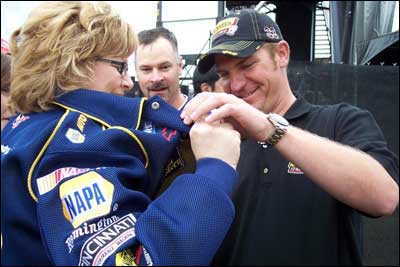
[February 19] June McFann relayed this note from daughter Julie, who attended the Daytona 500 NASCAR race last weekend in Florida. "This Bowyer is related to the Bowyers that lived around Pawnee Rock and Albert," writes June. Julie reported: "This is Clint Bowyer from Emporia. He had just gave a interview and was leaving, the guy to his right was trying to get him out of the arena and I yelled 'Drivers from Kansas give autographs to people from Kansas' and he walked right over and I had nothing to sign but my Michael Waltrip jacket and he signed it. "He asked where I was from, I mentioned that some of my family is from around Emporia and he said, 'Ya think we might be related, ya never know and likes to hear from his fans from Kansas!' That was so cooooool!" Bowyer, by the way, finished fourth in the Sprint Cup series race on Sunday. He's the defending champ in the second-tier Nationwide series, and he came in third in Saturday's Nationwide race. He has winnings of more than $700,000 after one weekend of racing. The bricks: Several folks sent really informative e-mails about the bricks and churches mentioned yesterday. To give more people a chance to send their thoughts, I'm holding off on printing them until Friday. The bricks of Pawnee Rock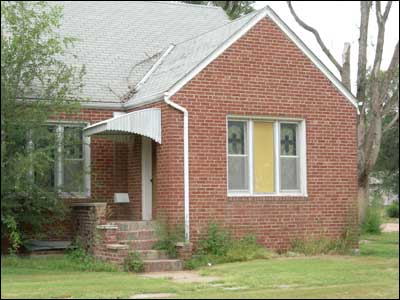
Was the Methodist Church, which replaced a building that burned, built with bricks from a Pfister kiln? [February 18] OK, long-time Pawnee Rockers, here's a question that will test your memory for details. I suspect that Kansas Brick, between Great Bend and Hoisington is involved, but Kay Steed is asking a lot more: My son was on a sales call in Tonganoxie, Ks., and met a woman whose maiden name is Pfister and she is from the P.R.-Gt. Bend area. With our connection to the Pfister name, we are trying to figure out who she is. I don't know why, but my son didn't ask her name (KIDS). She said her family made bricks and their name is on the bricks. She also said they laid the bricks on the streets of P.R., which we have all agreed couldn't be right because there are no brick streets in P.R. Is that correct? She also said the family bricks were used to build some of the churches in P.R. My question is, do you or anyone, know the name on the bricks? We think she might be the daughter of Dan Pfister, who was a brother to Cecil Pfisters' dad. Cecil was married to my mother's cousin Velda (Foster). He did have 6 sisters, but none of them are living. I'm just curious as to who this family might be. Do you have any ideas? Thanks, Kay Worth a trip to the Flint Hills: Pawnee Rock expatriate and Emporia Gazette columnist Cheryl Unruh wrote about driving from Emporia to Great Bend under the diligent guidance of her new GPS device. Check out "Recalculating." Andrew Deckert and 36% interest
The Andrew Deckert family's farm northwest of Pawnee Rock. The photo comes from the "Biographical History of Barton County, Kansas," published in 1912. [February 17] Farmers are historically on the financial edge, but the case of Andrew J. Deckert suggests that it has been tough since the days when Barton County was a new square on the map. Here's the saga of Andrew and Susan Deckert, who lived in the northwestern corner of Pawnee Rock Township. (The 1916 plat was sent by Larry Smith.) The story is from the "Biographical History of Barton County, Kansas." Andrew J. Deckert
Andrew started out for himself when he became of age and on November 18, 1886 was married to Miss Susan Boese of Pawnee Rock township. Ten children were born to the union: Minnie who married Henry Jantzen and Anna who married Luis Jantzen, both of Pawnee County. The other children live at home. Mr. and Mrs. Deckert started in 1886 with nothing and it wasn't long until they thought they had even less than that. They rented land at first and while crops were of varying yields managed to get along. Then is 1891 when he had saved $1,000, he bought a farm and made this as a payment on the same. There were four years of bad crops and he lost the entire payment. Undaunted he went ahead, paid 36 per cent interest on borrowed money and in 1896 paid out on a new contract which he had made for farm land. He now owns 320 acres of land in section 7, the home place, 160 acres over in section 8 and 160 acres in Pawnee County. The home place is one of the modernly improved farms of the county and is fixed up in the best of shape. The house is a one and a half story structure, containing 11 rooms, the upper story being arranged with dormer windows in the gables which give the house a good appearance and leaves plenty of room. There are large barns and other buildings and one of the chief buildings of interest on the farm is a large elevator, which houses 9,000 bushels of grain. Seeking photos of 417 Pawnee Avenue
417 Pawnee Avenue in January 2005. [February 16] Kristina Frost would like to see photos of the house at 417 Pawnee Avenue. It's the second house from the alley on the south side of the street, just west of the old grocery store. The only photos I have are like this one, and I don't think I have an older one. Does anybody else have an older photo of Pawnee Avenue houses in their prime? If you have such a shot, please send it to me and I'll forward it to Kristina. Plan for the Lions' noodle dinner
[February 15] The Pawnee Rock Lions Club, which meets in the depot downtown, is preparing for its annual noodle dinner. Here's the word from Janice Schmidt: For all who read and are within driving distance, Pawnee Rock Lions Club will have homemade noodles with chicken or beef on March 7, serving from 11 a.m. till 2 p.m. in the depot. We will also have a drawing for prizes: $25.00 cash, $25.00 Wal-Mart card, oil changes, fleece throws, and more. So come on down and enjoy. $6.00 adults, $4.00 children under 4 years. Correction: Also, Janice was kind enough to mention that a few days ago I had associated the Rev. Parker with the wrong church. He was the minister of the Christian Church, and I've corrected the original post. Thanks, Janice. This is for you, June
[February 14] Early in the week, Marsha Bouker asked to have her mother honored today. No one could say it better than Marsha: "I would like to have you put a Valentine Greeting to my Mother (June McFann). ... I would like to make her day special." Happy Valentine's Day, June. Everlasting friends[February 13] Several readers sent me nice notes about Pete Goering, for which I am deeply grateful. Thank you. Rick Clawson added this: "Good people and good friends are hard to come by. Though we eventually have to part ways, there is that place in our souls of the good memories we shared with these people that never leave us.
"People like Rodney and Pete, we never forget. They are gone but left behind treasures with good memories." My friend Pete Goering[February 12] When I was in college, I was a part-time sports writer for the Topeka Capital-Journal. Covering the Jayhawks was fairly big stuff for a kid from Pawnee Rock, but I had a friend at work -- Pete Goering. Pete, a full-time sports writer who was eight or so years older, was a gentle guide in a world of big egos. He encouraged me to get to the point and to ask more questions, and he insisted that I file my stories on time. The road trip we took together to Stillwater for a football game -- tooling along in his red BMW -- was the best time I ever spent with a sports guy. I like to think that Pete saw some possibility in me because he grew up in Lehigh, in Marion County, and for a couple of years went to Bethel College, the Mennonite school in North Newton, and then to K-State. He knew what it was like to be a small-town guy in a hurry-up world. The last time I corresponded with Pete was not long after he had become the executive editor of the Capital. He was as modest as before, but his humor had more depth -- it seemed slightly melancholy -- which I assume came with his job. Pete died of cancer last Friday and was buried yesterday in Topeka. May he rest in peace. Four days in a house's life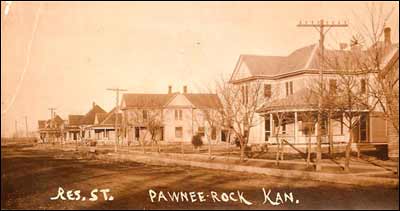
[February 11] I found that I have images of a house in four stages of life. It's the place on the northeastern corner of Cunnife Avenue and Rock Street, a house where the Christian Church preacher Beverly Parker and his family once lived. This is one of my favorite houses in Pawnee Rock. Its rounded porch is a giveaway clue to its age. Personally, I have good memories of it because when I was looking to buy a car in high school I was offered an enormous chrome-encrusted Buick stored in the home's wooden garage along Rock Street. The oldest image is on a postcard sent by Larry Smith. The photo apparently was taken in the very early 20th century.
The second photo shows the house on fire in the 1940s, in the days before Pawnee Rock had its own fire truck. Fred Fry made this photograph.
The third photo was taken in October 2003, and the house, despite its attempt at being colorful, looks as if it's ready to be knocked down.
Finally, the fourth photo, made in January 2005, shows a resplendent house with a new coat of paint. A plant with a point and a pod
Yucca in Pawnee Rock State Park, August 2006.
[February 10] Anybody who has walked at night on Pawnee Rock or through a neighbor's flower garden or across the unbroken country west of town has strong feelings about yucca. This is a plant an insurance company would never allow, but it's as Kansan as can be. I've left my share of skin on yucca needles, and I've gone home with a couple of yucca needle tips in my legs. It makes my skin crawl even now. But the yucca has a charm unlike any other wild plant on the plains -- it looks so darn western. The waxy flowers are beautiful, and the late-summer seed pods are sized to fit a kid's hand. With prying fingers, a curious kid -- perhaps the same one who laughed at the idea of naming a plant yuck-a -- can find a world of wonder inside a pod. In some quarters, yucca is regarding as a noxious weed and an annoyance to cattle ranchers. But I like the yucca. It's tough and pretty and lonesome.
Three bridges
Under the Pawnee Rock Bridge, 1974, looking east across the Arkansas River. [February 9] As a boy I played around the pilings just downstream of the Pawnee Rock Bridge. They were somewhat oily despite having stood in the Arkansas River since (as far as I was concerned) the beginning of time. The pilings were part of the landscape, and I didn't really give them a second thought. That is, until this past week when I came across some photos I made 35 years ago. The images show the pilings and the somewhat rickety wooden bridge that succeeded the one the cut-off pilings used to support. That got me wondering about the first bridge, which I've never seen in a photo. Eventually my research took me to this terraserver-usa.com satellite photo, which was made in 1991.
Finally, I understand why the road curves as it does on that flat landscape -- it's to accommodate the second bridge, which apparently was put up while the first bridge was still standing. In the satellite shot, it's easy to see the old roadbed on the north side of the curvy asphalt road (the really straight lines east of the river are saplings planted in a shelterbelt). And now that I think about it, I remember walking across the remnants of a road -- gravel and tar -- when we were taking a shortcut from the bridge to Earl Schmidt's sandpit. When I was in Pawnee Rock in the summer of 2000, I made some photos of the newest bridge -- the concrete bridge -- being erected. The photos show the second bridge's pilings on the upstream (southern) side of the concrete bridge, so it looks as if the newest bridge filled the original bridge's slot.
I know the second bridge had its faults, just as the first one must have had. I never really felt safe driving over a bridge that had been partly washed away in a 1960s flood, and anyone who walked over the bridge could catch a toe in gaps in the asphalt. It was fun for us kids to stand under the bridge when a truck rumbled overhead, because it would shake sand loose from the crossbeams. Even kids of marginal athletic ability could scramble up the X-bars between the pilings. All that is gone now. Progress is progress, but I miss the old bridge. It had history. It also had the occasional household appliance caught in its mossy pilings, and it also had small fish swimming in the lee of those pilings. The bridge, paired with the river, was alive. The newest bridge -- stylistically a pile of Legos -- has no forest of wooden poles to catch brush and driftwood brought by rising waters, and the Arkansas swims past untouched. Literally, it is streamlined, and traffic passes overhead without a care.
Under the newest Pawnee Rock Bridge, 2006.
Looking west across the river on the upstream side of the bridge.
It's smoother driving now over the Arkansas River than it was a dozen years ago. The accidental cat owners[February 9] Leon Miller writes about cats: I have to agree with you about the indifference when it comes to cats. I used to not care for them either. However, back in 2000 my mother-in-law came to live her last days with us and moved here from Fresno, California. She was 92 at the time. My wife went out there to assist her in closing down her house and moving back to Texas. One of the conditions of her coming here was that her two young cats had to come along also (they were about 1 1/2 years old at the time.) After spending a couple hundred dollars on vet bills, getting them shots, etc. my wife bought a carry-on cage for each cat as well as the own ticket ($75.00 each) and brought them to Dallas, at a total cost of around $350.00. My mother-in-law died the next summer at age 93 and we were left with her memories -- and her cats! Nine years later we still have the cats and ironically, they have become so much a part of our family that we sometimes think twice about going on a trip for fear of what we'll do with the cats. Thankfully, we have a neighbor who lives across the street who takes care of them under such circumstances. Since don't have grandkids we now have "grandcats" and love them to death. So be careful what you wish for or are glad you don't have. Someday you may find yourself with a loved one's cat you have to take care of. Curiosity and the cat
[February 8] The trouble with cats -- and puppies and kids -- is that they grow up. They outgrow the innocence that makes them so much fun to be around, and no longer can you trick them by dangling a piece of string in front of their nose. The same goes for kittens and puppies. Little animals are a blast. They sneak and pounce. They are amused by the littlest things. Our son Nik's beagle, for example, is fascinated by the shadows cast by snowflakes that fall under the streetlights. I like to think you and I were that way too, and no doubt that made for many treasurable moments for our parents. I've never been a fan of cats. Some people don't like broccoli; I don't care for cats but would be the first to say they're more fun to pet than is broccoli. Still, the old memories of watching my sister's kitten stalking the wildlife in our overgrown backyard in Pawnee Rock is one of my favorite animal memories. Curiosity never did kill this kitten. Like kids and puppies, the kitten grew up and became jaded by the things that used to amuse it. Then we were stuck with a cat, and the cat was stuck with people who no longer found amusement in every little thing she did. In retrospect[February 7] I have to agree with the poet of Indianapolis, Ray Randolph, who thinks we all could pay better attention: I hear you only too well about listening as well as seeing. Photographic history is one thing, oral history is another. Together, they are "dynamite." Working on genealogy, I beat myself up so much for not asking the right questions of the right people at the right time. It's too late now. The phrase: "If only I had known then what I know now and want to know now." But, of course, I wasn't interested in genealogy at "the right time." As you said about looking at the pictures and wondering, I look at many of the old pictures from albums and (because many of them weren't identified to person or place or time) I am left to wonder and try to deduce or intuit identities. We all have so many memories and stories, but at least we are fortunate to have some photographs/snapshots as a basis for some of those memories and to stimulate further investigation. I collect many photos (maybe too many!) and use them as my slide-show screen saver on the computer. Dressed for work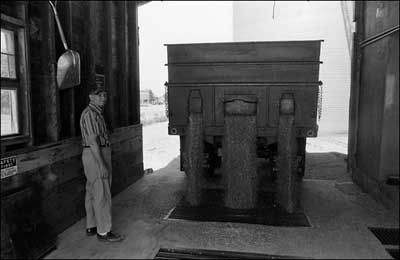
[February 6] In 1976, I didn't think anything of it when I photographed this man working in the Dundee elevator. But now I see things that speak to a lost age. His shirt is tucked in, and he wears a belt on his slacks. He wears not boots but scuffed black leather shoes. His socks are white. He stands straight, and his cap sits on his head the way it should. I like the idea that at a time when shirtless young men were doing the grunt work in Pawnee Rock, this fellow dressed in the way that was comfortable for him, and he worked at his speed. He knew the farmers and their sons. When I look at the photos above and below, I smell the wheat and its dust. I hear the wheat as it pours into a pile and through the grate, and I hear the elevator machinery and the rush of semis and cars outside. I feel the heat, as dry as June can be. But what I can't pull out of this photo are any more details about this fellow. I don't know his name or what he was like or how many years he had held that grain shovel. I was 20 years old and willing to pass the summer in search of photographic trophies that told a story, but I should have listened to the people in the viewfinder.
Finding old books
"The Corner Stone" -- Love is found on Pawnee Rock in this piece of an illustration by J. Allen St. John, who also illustrated the Tarzan books. [February 5] In these days of print-off-the-Internet publishing and books manufactured by the oceangoing-shipping-container-full in China, it's fun to think back to a time when books were treasured. "The Corner Stone," discussed here yesterday, was one of those delights. In its soft leather cover, it was meant for use by people who washed their hands first and didn't read at the lunch table. Maybe there are still some of these books tucked away in attics around Kansas. Leon Miller wrote: "I vaguely recall seeing this book in an estate sale we had for the Miller family back in 1968. Arthur Miller, my grandfather I never knew, died in 1928. But for some reason the heirs never settled the family estate until my dad and his brother, my uncle, Vic Miller died in the summer of 1967. They had stuff going back to the turn of the 20th Century." Larry Mix wrote: "The way I look at anything you find that you want the price depends on how bad you want it or how bad another person wants it. I know I've paid outrageous prices for things about the trail that a lot of people would think I'm was crazy. When I was buying books off of Ebay, the way I would do it is look at the places on the net that sell used books. Two of them that I use are: • abebooks.com (listing for The Corner Stone) • www.biblio.com (listing for The Corner Stone) "By using this method you see that this book is worth from $5.54 to $89.99, so you see it boils down to what ever you are willing to pay for it."
• eBay.com (listing for Echoes of Pawnee Rock, compiled by Margaret Perkins) Happy Birthday, Mandy[February 4] This urgent message came early today: Would you give a shout out and a Happy Birthday wish to Mandy (Steed) Shelton today? 31 years young, from her loving Mom. The Corner StoneMay air, shot through with gladsome morning light, overhung all the prairies, swathing the brow of old Pawnee Rock with a diaphanous veil filmy and fine as the draperies the master painters once drew about the shoulders of rare old Madonnas. Wide away the landscape stretches in lengths of shimmering green checked across by flat brown roadways, and melting at last into a mist of lavender-gray. The only break in all this level realm is Pawnee Rock -- grand old citadel of the Plains, upreared in its majestic loneliness -- the watch tower of the prairies through uncounted centuries.
The story is written in lush prose, which makes it all the more fun to imagine our grandparents and great-grandparents reading The Corner Stone as they sat in the porch swing on a quiet evening. Maybe it scandalized a few busybodies, but I suspect that it was too sweet to do any such thing for most people. I found my copy a number of years ago in a used bookstore in Anchorage. I paid $40, and I would have paid more. It's in great shape, with a soft leather cover, beautiful illustrations and thick pages. This comes up because I received an e-mail from a woman named Deanna. "I have inherited an old book about Pawnee Rock," Deanna wrote. "The name of it is The Corner Stone, by Margaret Hill McCarter, published 1915, copyrighted in Great Britain. It is in excellent shape for its age, still in its original box. Book cover and box are made of a certain type heavy paper (stiff), with wheat stalks for designs. Talks all about Pawnee Rock and its view. "Would like to know if this book is worth anything. If you know of anyone who can help, please let me know." So, if any of you know more about the book's value, please let us know. Cellar of truth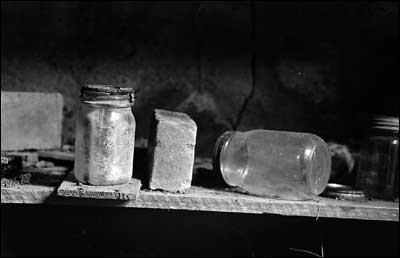
[February 3] One thing I liked about going to Grandma Unruh's farm was the possibility of discovering something interesting. I had been going out there for as long as I was alive, but it wasn't until I was an adult that I developed a reasonable sense of wonder. Up until then, I suppose, I assumed that the whole world had been arranged for my benefit. In my 30s and 40s, I began to understand -- or, at least, to realize that I was beginning to understand -- the lives that had come before mine.
After Grandma was delivered to the nursing home and before her death in 1989, my dad and I went to the farm several times. He had grown up there and enjoyed showing me the world he knew -- now that I was old enough to really pay attention. We walked the seven concrete steps down into the older cellar, which unlike the newer one had a concrete top shaped like a quonset hut. (WHen I was 10, this was the design I had based my Civil Defense bomb shelters on.) But going down there with Dad, it was different. He knew the whole place; he might even have put the shelves up himself and hung the bullsnake skin over a rafter. I photographed him in the half-light that came down the steps, and until I looked later at the photo I didn't realize how roomy the cellar was. Old canning jars and their lids were on the floor and shelves, which were by then resting awkwardly on their skimpy frames. Rusted wire -- the string that holds a farm together -- supported some of the planks from above. The timbers had been painted once since the farm was created in 1906, and bits of lead-based white still clung to the wood. The concrete walls had grown a couple of cracks, and I marveled that the cellar hadn't collapsed inward. This was the family's pantry and its hilltop protection against tornadoes. Dad felt as comfortable down inside as I was antsy. For me, going into the cellar was an amusement. For Dad, it was his life.
News in September 1989
Vivian Bright, left, and LaWanda Hendricks in 2006 outside the depot. February 2 On September 6, 1989, the school year had just begun, Labor Day had come and gone, and Pawnee Rock was gearing up for the eventual arrival of autumn. All of this was recounted in the Pawnee Rock Community News, edition No. 47. Here are excerpts from the four-page newsletter: Ministerial AllianceWe are glad LaWanda Hendricks has recovered from surgery and is now able to edit the paper again. Thank you, LaWanda. We also that those who edited the paper in the interim -- Rebecca Peak and Muriel Bennett. If you would like to offer your services to run the copy machine and stapler for the paper, please tell one of the ministers. Methodist ChurchUnited Church Women will meet Thursday, September 14 at 2:00 PM. Eloise Converse is to be hostess and Norma Kasselman has the lesson. Mark your calendars! There wil be a Chuck Wagon Supper on September 23 with serving from 5 to 7 pm. Musical entertainment will be included in the evening. Wear old time clothes and come engoy grilled hamburgers, hot-dogs, baked beans, potato chips and watermelon. All for a free will donation. Everybody in the community is invited! News from City HallThe City Council of Pawnee Rock announces the appointment of a City Clerk to replace Doris Bryan. Brenda Gross has been in the City Hall since August 1. City Ordinance #244 setting the water rates and regulations has been passed. A copy can be obtained at City Hall if you didn't see the publication in the Great Bend Tribune on August 14. Generally, the monthly rates for $10.00 minimum for up to 2,000 gallons and $1.50/1000 gallons over the first 2,000 gallons. All households wishing to hook up to the water system must fill out an application with a $5 fee. A $50 deposit will be required of all occupants in a rental property, to be returned with interest after a year if you are a customer in good standing. School newsA new school year has begun at Pawnee Rock School. They wish to welcome two new teachers to the system. Marcy Wagner, middle school (6th, 7th, and 8th grades) math and science, volleyball coach, boy's basketball coach and assistant track coach. She is married, husband is Gary and they reside in Larned. She graduated from the University of Nebraska last December. The other new teacher is Natalie Ruge who is a librarian for both the elementary and middle school and a concession stand sponsor. She graduated from Oklahoma University and came to USD #495 from Argonia where she taught for 3 years. She also resides in Larned. Good news for football fans -- Pawnee Rock will have a football team this year -- their coach is Berny Bailey. They have 10 boys out for football. Their first game is the 28th of September in Pawnee Rock with Bazine at 7:00 PM. Mr. Lyle Parks states the enrollment in the Pawnee Rock School this year is 96 students -- 66 elementary and 30 middle school students. He is expecting a really good year and really appreciates all the students. Community newsThe Lions Club will meet on September 11 at 7:00 PM in the depot. Debbie and Tracy Bright from Macksville are the proud parents of a baby boy. Name Justin Erin, 8 lbs, 13 oz. He has three brothers. Grandparents from Pawnee Rock -- Lawrence and Vivian Bright. Marian Mull went to California with her two grandsons to visit her sister-in-law Elaine Schmitt, also Annella and Eldon Smith in San Diego. They had a tour of the San Diego church. Bessie French spent the past week-end in Salina visiting her sister-in-law, Mrs. Clifford French. Also visiting were her sister-in-law and brother-in-law from El Dorado. A new Manager has been obtained for the Senior Citizens. She is Donna Mickle. You may call her before 8 in the morning to be able to attend the noon meal for that day. Our deepest sympathy to the family of Roger Unruh, who passed away on September 4. Roger was a lifetime resident of the Pawnee Rock area, former postmaster and very involved in the community. He will be missed by all. KAREN'S HAIR FASHIONS located next to the Post Office is open on Wednesday, Thursday, Friday and Saturday to serve your needs. Haircuts (men, women, children) hair sets, rinses, colors, perms and manicures. Also Redken products available. Call for your appointment today. LibraryThe 1989 Summer Reading Program at the Pawnee Rock Community Library began on June 5 and ended July 28th. A total of 259 books were read. Those participating in the program were: Kayla Bunch, Phillip Bryan, Benjamin Bryan, Jessica Basgall, Ryan Russell, Amber Basgall, Dea Bunch, Elizabeth Adams.
Karen's Hair Fashions was in the building just north of the post office. This photo was made in 2006. Happy Prairie Dog Day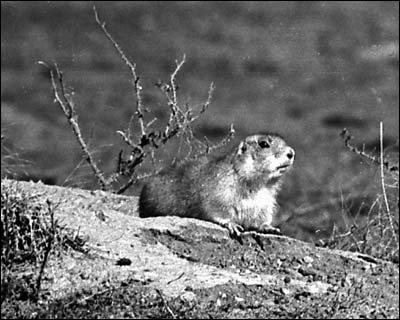
This prairie dog, watching the world from its thorny, dusty mound, lived south of Pawnee Rock in the 1970s. The photo was made in the winter. [February 1] Today is Prairie Dog Day, when we celebrate the historic anniversary of the winter when prairie dogs saved Pawnee Rock from starvation. (Read the legend.) Although the original practice of hiding gifts in the prairie dog holes vanished after World War I, there are other ways to celebrate that don't involve parking alongside the road and climbing a barbed-wire fence, not to mention annoying the cattle. In my reading, I've discovered Prairie Dog Day practices once enjoyed by our forebears. A good many families marked the occasion by "Dogging," an activity that involved leaving root vegetables on neighbors' porches -- what a happy sight it must have been to watch children run up to a home, place a carrot and potato on the steps, knock on the door, and scamper off to hide behind an elm and watch the recipient's delighted expression. Others hung Bless Our Prairie Dogs banners and ribbons in their homes. The most dedicated folks dug holes in their yards (and filled them in again just before going to bed or early on February 2). Pawnee Rock's lone attempt at a Prairie Dog Day parade was canceled during the Great Freeze of '24, although there later was talk in the Pawnee Rock Herald of trying again someday. Tomorrow we'll be up to our eyeballs in cliches about groundhogs and an obscure town in Pennsylvania whose claims to fame are that it has an "x" in its name and that its overfed pet groundhog appears on TV every February (it's in the same time zone as the morning news-show studios). Our prairie dogs, however, are noble mammals of the plains whose legend of generosity is as fresh as the prairie wind and as old as the brown soil under our feet. Keep the legend alive. Today, when you're greeted, respond not with "hello" but with "Happy Prairie Dog Day!" Street View of Pawnee Rock[February 1] Larry Mix of St. John was kind enough to point out that Google has run its photo car through Pawnee Rock on U.S. 56 -- and now we have a reasonably fresh view of what the town looks like from the highway. (See it.) For those unfamiliar with Google's Street View: Open the map and pull the little yellow man onto the map. Any street that has been photographed will show up with blue lines. Place the little man's green circle on the road where you want the view. Move up and down the road by clicking on the white arrows, and shift the view around by grabbing the map and moving it. If you're of a mind, you can follow the highway, visiting Larned, Dundee, and Great Bend. Now, if only Google would improve its satellite view of Pawnee Rock, I'd be happy. The high-resolution image stops about two miles northwest of town. |
Sell itAdvertise here to an audience that's already interested in Pawnee Rock: Or tell someone happy birthday. Advertise on PawneeRock.org. |
|
|
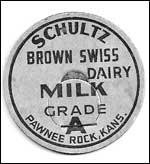 Mrs. Schultz was the widow of Dewey Schultz, and together they ran the Schultz Brown Swiss Dairy. She was a busy woman. Her obituary notes that she was a member of the Fort Larned Chapter of D.A.R. and a past member of the Ash Valley Grange, the Larned Historical Society, the First United Methodist Church, and the Pawnee County EHU, all of Larned, and she served for many years as a 4-H project leader.
Mrs. Schultz was the widow of Dewey Schultz, and together they ran the Schultz Brown Swiss Dairy. She was a busy woman. Her obituary notes that she was a member of the Fort Larned Chapter of D.A.R. and a past member of the Ash Valley Grange, the Larned Historical Society, the First United Methodist Church, and the Pawnee County EHU, all of Larned, and she served for many years as a 4-H project leader.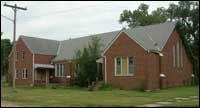 [February 20] Kay Steed wrote
[February 20] Kay Steed wrote  The Christian Church that's now standing is also made largely of brick, but it's newer than the three other churches. (If you have dates for the New Jerusalem and Christian churches, I be glad to hear them.)
The Christian Church that's now standing is also made largely of brick, but it's newer than the three other churches. (If you have dates for the New Jerusalem and Christian churches, I be glad to hear them.)
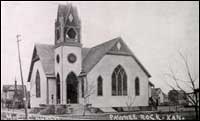 The original Methodist Church burned in the early '40s, and was a great personal tragedy at the time. The church building committee voted to build a new church even though it was shortly after the start of WWII and was a huge undertaking.
The original Methodist Church burned in the early '40s, and was a great personal tragedy at the time. The church building committee voted to build a new church even though it was shortly after the start of WWII and was a huge undertaking.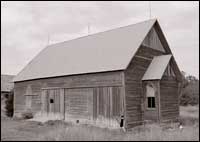 In 1973-74 I heard this story again from Ahila Hinds. Hinds' lived east of
main street on Bismark. For some reason or other we had gone out to their house on the Mennonite Church Road. They said that the building just east of their house, in the same yard, was the original Mennonite Church. They elaborated from there and during the conversation it came up that she had graduated from the Nettleton school and shortly thereafter they had torn it down and the bricks were brought to Pawnee Rock for the church.
In 1973-74 I heard this story again from Ahila Hinds. Hinds' lived east of
main street on Bismark. For some reason or other we had gone out to their house on the Mennonite Church Road. They said that the building just east of their house, in the same yard, was the original Mennonite Church. They elaborated from there and during the conversation it came up that she had graduated from the Nettleton school and shortly thereafter they had torn it down and the bricks were brought to Pawnee Rock for the church.
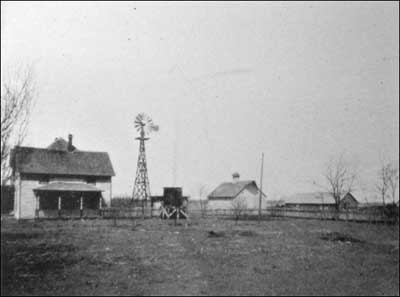
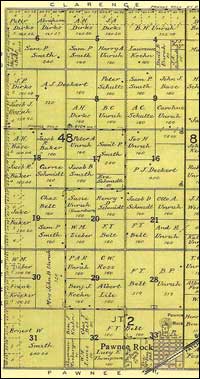
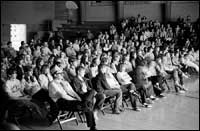
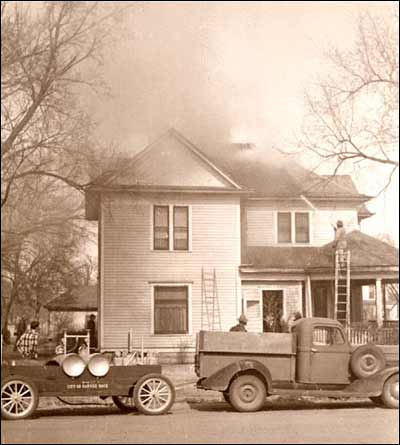
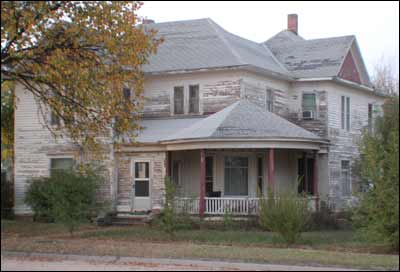
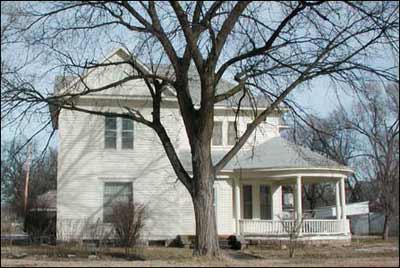

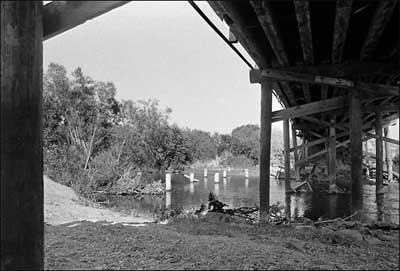
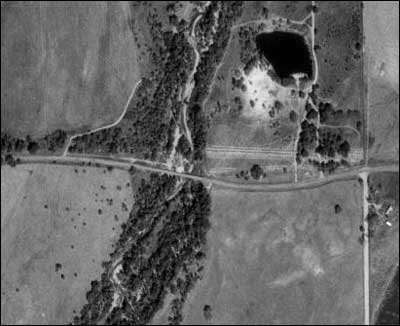
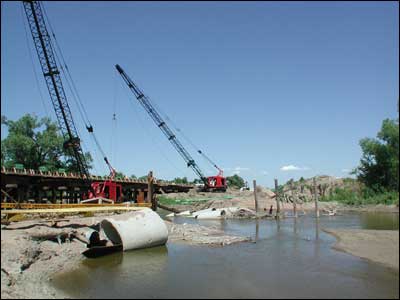
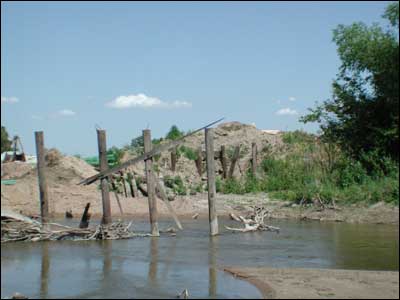
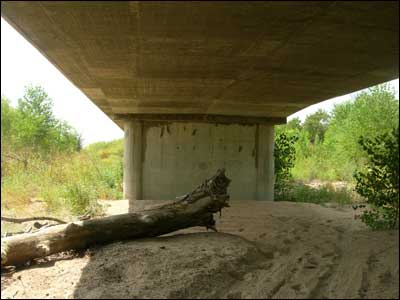

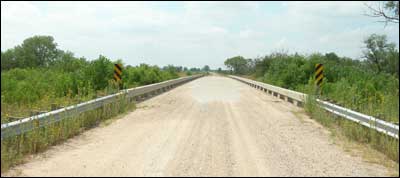
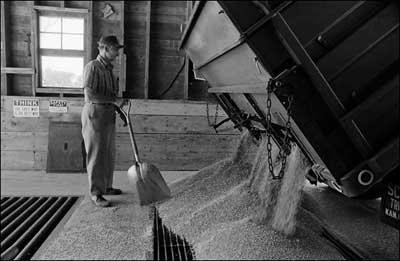
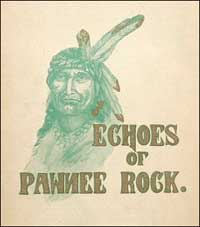 In a similar shopping vein, Gary Trotnic (who I know is good at eBay), wrote to suggest another Pawnee Rock book: "Echoes of Pawnee Rock." It was published in 1908 to raise money to pay for turning Benjamin Unruh's sandstone bluff into Pawnee Rock State Park. Its contributors include Gov. E.W. Hoch, who lived in our town briefly, and William Allen White.
In a similar shopping vein, Gary Trotnic (who I know is good at eBay), wrote to suggest another Pawnee Rock book: "Echoes of Pawnee Rock." It was published in 1908 to raise money to pay for turning Benjamin Unruh's sandstone bluff into Pawnee Rock State Park. Its contributors include Gov. E.W. Hoch, who lived in our town briefly, and William Allen White.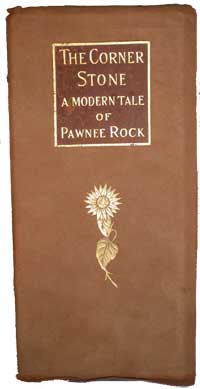 [February 4] And so begins "The Corner Stone: A Modern Tale of Pawnee Rock." This 100-page romance, written by Margaret Hill McCarter and published in 1915, may be the first and perhaps only novel ever printed about our hometown.
[February 4] And so begins "The Corner Stone: A Modern Tale of Pawnee Rock." This 100-page romance, written by Margaret Hill McCarter and published in 1915, may be the first and perhaps only novel ever printed about our hometown.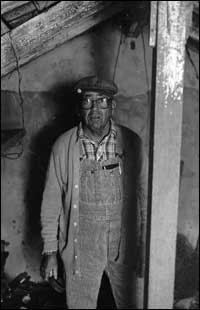 Take this root cellar, for example. The farm had two, and I wasn't especially eager to go down into either one. I feared the snakes that Grandma promised were in there, but even more frightening were the brown recluse and black widow spiders that newspaper stories told me to watch out for.
Take this root cellar, for example. The farm had two, and I wasn't especially eager to go down into either one. I feared the snakes that Grandma promised were in there, but even more frightening were the brown recluse and black widow spiders that newspaper stories told me to watch out for.